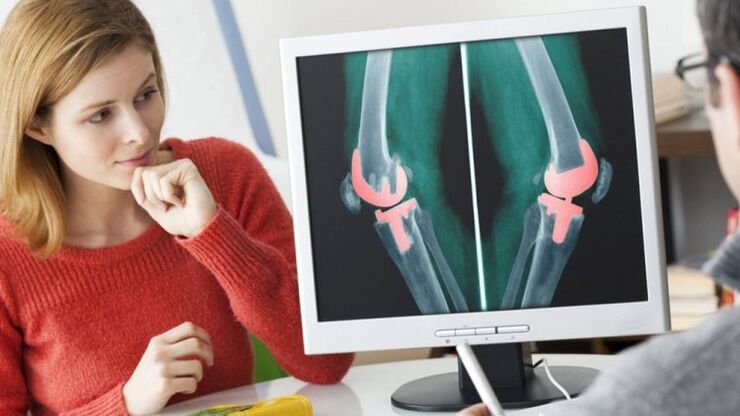Arthropathy is the most common joint injury in medical practice, and is related to the process of degenerative dystrophy that occurs in it. It is mainly caused by body aging and joint tissue destruction, which cannot be completely cured. However, according to experts, slowing down the process of destruction, delaying joint formation and maintaining joint health for a long time are a person's strength.
Arthropathy and its symptoms

The destruction of joints begins with the gradual wear and tear of cartilage-the main element of this movable connection of bones, which protects them from friction at the point of contact and acts as a shock absorber under mechanical stress. In most cases, this process is due to age-related deterioration of the body's metabolic processes and joint dystrophy. Therefore, the symptoms of the disease usually appear after 40-50 years. However, negative changes in cartilage tissue occur at an earlier age, including the gradual loss, thinning, and destruction of cartilage elasticity.
The inability of cartilage to fully perform its function will lead to negative changes in bone tissue. Bone tissue will grow and form osteophytes (growth in the form of nodules, spines, and hooks), which is the source of pain during exercise. Gradually, the pathological process covers joint muscles, ligaments, and tendons. The joints may be deformed.
The following symptoms indicate the development of joint disease:
- Pain that increases with exercise and physical exertion;
- Decreased joint range of motion;
- Swelling and inflammation (in some cases);
- Deformation and immobility of the joints (serious diseases).
Osteoarthritis mainly affects the knees, hip joints, lumbar and cervical spine, and hands.
Causes and risk factors of disease
The main reasons for the destruction of articular cartilage and the development of arthropathy include:
- Genetic predisposition
- Joint damage, which may be mild but repeated many times, or one-time but severe (for example, meniscus damage);
- Age-related changes in cartilage and bone tissue.
Some factors increase the possibility of joint disease. The main reason is excessive weight, which will increase the load on the joints, and a sedentary lifestyle, which will interfere with the normal blood supply and nutrition of the joints and impair their metabolism. Excessive physical activity, local inflammation, and hormonal changes (such as menopause) can also cause arthropathy.
Treatment or prevention?

It is impossible to completely cure this disease-this is the common judgment of rheumatologists, whose task is to fight joint disease. Modern therapy can slow down the destruction of cartilage, reduce inflammation, relieve pain, and improve the patient's condition. For this reason, when treating arthropathy, they use:
- A chondroprotective agent based on chondroitin sulfate and glucosamine;
- Non-steroidal anti-inflammatory drugs;
- Intra-articular injection of hyaluronic acid or hormone drugs;
- Physiotherapy procedures (ultrasound, electrophoresis, laser and magnetic therapy, mud application);
- Physical therapy exercises.
In severe cases, they resort to surgery and replace joints with prostheses.
The main task of fighting disease, modern medicine considers the prevention of joint disease and the promotion of a lifestyle that helps maintain joint health. First of all, this applies to teenagers and young people who are actively involved in sports, who need to develop special skills during training to protect the joints (warm up and warm up of the joints, use special protective devices: knee pads, elbow pads, etc. ). For those who do not participate in sports, the main measures to prevent joint disease are to maintain a normal weight and physical activity.
Weight loss and nutrition

The results of a large number of studies have shown that obese people have a three-fold increase in the risk of joint disease. This is not only because being overweight will increase the load on the joints, but also because too much fat will trigger the development of many pathological processes in the body, leading to serious diseases such as type 2 diabetes and cardiovascular disease, which have a negative impact on the condition of the joints.
Nutrition for preventing joint disease aims to fill the body with the nutrients needed for the normal function of articular cartilage and slow down the degradation process. Adhering to the following basic principles will not only help keep your joints in good condition, but also prevent excessive weight gain:
- Reduce the calorie content of food by eliminating or limiting fat and poultry;
- Consume enough low-fat dairy products to provide calcium for bones;
- Increase the ratio of grains, vegetables and fruits to supplement the vitamins and trace elements needed by the joints for the body.
During the nutrition process, special attention should be paid to foods and dishes containing natural substances that protect and strengthen cartilage tissue. These substances first include collagen-a protein that is part of animal and fish cartilage, ligaments and skin. For this reason, it is necessary to add aspic, aspic (especially fish), jelly and other dishes containing gelatin (a modified collagen) to the diet.
Physical activity to prevent joint disease

A sedentary lifestyle is one of the main enemies of human health, including its musculoskeletal system. Although physical exercise allows you to achieve many of the goals needed to maintain joints and overall health at the same time:
- Improve blood circulation and tissue nutrition;
- Normalize the metabolic process and prevent excessive weight gain;
- Develop muscles to strengthen the skeletal system;
- Train all body systems and improve immunity;
- Improve mood.
In order to keep the joints in good condition, they should not be overloaded. But this does not mean that you should give up physical exercise. Exercise is absolutely necessary for the joints, but it should be moderate, depending on each person's individual characteristics such as body shape and age.
Experts say that walking is the best preventive measure for knee joint disease of any age, and they recommend walking at least 6, 000 steps a day. Swimming is very beneficial and has no negative effect on body weight and bones when exercise occurs. Participating in any sports-related sports or favorite activities (dancing, gardening, outdoor games with children), as long as they participate regularly, it will help prevent joint disease and keep joints in good condition for a long time.

























